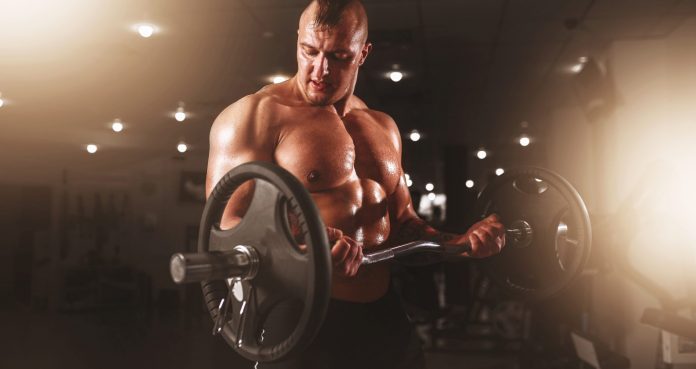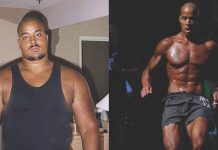
Building muscle is hard work. And the longer you do it, the harder it gets.
You’ve probably experienced that yourself. In the first couple of years of training, your gains come relatively easily. But then, having built a foundation of mass, you find yourself struggling for every ounce of additional muscle gain. To keep making gains, you’ve got to train harder and smarter than you did before. In this article, we’ll lay out 10 proven tips to take your workouts to the next level to boost your muscle gains.
Tip #1: The Burn Out Set
On your last set of any exercise, finish your muscles off by giving them a super pump by doing 25-30 reps with a very light weight. A Japanese study concluded that you can increase strength and muscle cell size by flushing in more blood and water with a very high rep set done after your normal working sets.
Tip #2: Take Your Delts Out of Your Chest Work
You don’t see too many guys with fully developed upper pecs – but you do see a lot with huge front delts (1).
Have you ever thought that there might be a connection there?
There most definitely is – the front delts are taking over their chest pressing work – especially on the incline press. Of course, your goal is to cut the delts out as much as possible, so that you can maximally involve your pecs.
So, how do you do it? Well, it all comes down to the angle of your bench.
Most guys have it way too high. Think about it – if the bench was completely upright at 90 degrees, you’d be doing a shoulder press – and if it was flat at 180 degrees you’d be doing a flat chest press.
Clearly, then, the lower you go the more chest involvement there is. Yet, most guys set the angle at 45 degrees or higher for the incline bench. That is way too high if you want to cut out the front delts.
So, what’s the ideal angle?
30 degrees.
At 30 degrees, it’ll be all pecs. You won’t be as strong, because you won’t be getting the extra help from the shoulders, but you will be placing all the stress where it needs to be if you are after upper chest growth.
Try setting your incline at 30 degrees on your next chest workout – and just note how much more pec involvement you will feel – and how much sore your chest will be the next day.
Tip #3: Perform Breakdown Sets
Breakdown is a method of training that allows you to hit all the different muscle fiber types during a single set. It was devised by the founder of the International Sports Sciences Association, Dr. Fred Hatfield (aka Dr. Squat).
Perform three-phase sets as follows:
- Do 4-6 reps with 85% of your one-rep max
- Change to a weight that is 20 percent lighter and perform 10-15 reps
- Change to a weight that is 50 percent lighter again and perform 25-30 reps
There is no rest between the phases of the set. This method will allow you to stimulate muscle growth by hitting the full spectrum of fast and slow-twitch muscle fibers (2).
Tip #4: To Pack on Size, Stick to the Basics
Basic compound moves such as the squat, deadlift, bench press, overhead shoulder press, and barbell curl should be mainstays of your program. These exercises have been proven time and time again in helping to build a solid foundation of muscle. Do the first in your body part workouts when your energy level is high, and choose challenging weights that maximize strength (4-6 reps) or size (8-12 reps) gains.
Tip #5: Use Negatives
Negative reps, where you lower the weight very slowly, can actually contribute to more muscle soreness and tissue breakdown than positive reps. Due to the higher degree of generated intensity, you don’t want to overuse this technique. For that reason, you should limit negative training once every few weeks per body part.
Here are a couple of ways you can use negatives to boost your muscle gains …
- Put 20 percent more weight on the bar than you normally would and have your partner assist you when lifting the weight while you focus on the negative, Aim to take 3-5 seconds to lower the weight.
- Do negatives at the end of your set. Once you reach positive rep failure, have your partner help you with a couple of extra forced reps while you lower the weight as slowly as possible. Remember that speed counts – do ultra-slow reps and you’ll ignite dormant muscle fibers.
Tip #6: Iso Tension
You’ve probably heard about the concept of time under tension (3). It relates to the ideal length of time to maintain tension on the working muscle group during a set. Research indicates that that ideal time is 45-60 seconds.
The problem is that most guys complete a set of 8-10 reps in about half that time. Well, there’s a fantastic way to extend the set and severely ramp up the intensity – and productivity – of the set.
It’s called iso tension, and here’s how it works . . .
Perform a set to failure. Let’s say that you manage to get out 8 good reps. After that last rep, hold the weight in the flex position for as long as you can. You’ll feel an intense burn in the target muscle – which is precisely what you want – fight the burn as long as you can…
It means growth!
Tip #7: Lat Pull Ins
The lat pulldown is meant to target the back, but too often it becomes a bicep dominant exercise. Often the problem is that we don’t maximize the stretch of the lats, which prevents us from getting a strong enough contraction.
To maximize your lat stretch you need to change the way you sit on the lat pulldown machine (4). Rather than straddling the machine and anchoring your knees under the pads, try sitting side-saddle with just one knee anchored. Now perform single-arm lat pulldowns. This will allow you to get a side-twisting stretch in the lats. When you pull down, rotate the lats back and down to get max contraction.
When you do your pulldowns this way you will get a whole lot more lat activation. As a result, you’ll be able to build bigger and wider lats.
Tip #8: Bench to the Neck
The barbell bench press forms the mainstay of many guy’s chest routine. However, the way they’re doing it may not be optimal for chest growth. The traditional form has you bringing the bar down to the mid or low sternum. This is not ideal.
Bringing the bar down in the traditional way drops the elbows down, emphasizing the anterior delts. But, in order to get the full recruitment of the muscle fibers of pec major, the elbows have to be up. This allows the fibers to run at an angle from the humerus to the sternum.
By pressing to the neck you will achieve this ideal elbow position to allow the chest fibers to fire during the movement.
Bench pressing to the neck will feel totally different. For maybe the first time, you will feel the activation right throughout the pecs – which is exactly what a chest mass builder should be doing.
Tip #9: Squat Depth
You know that to get the best leg development you have to be performing full squats. The problem is knowing how far to go down when you have got the weight on your back.
The solution involves four simple steps:
- Always squat inside a power rack.
- Adjust the side frame rails so that when you are down at the bottom of the squat, the bar just touches them.
- Perform a warm-up with just the bar where you are squatting all the way down until the bar touches the side rails.
- Only count the reps where the bar touches the rails – if you don’t go down far enough, do it again!
Making this one adjustment will make sure that every rep you do will be fully working your quads, glutes, and hamstrings. Your squats will be purer – which will make your entire body more powerful!
Tip #10: Muscle Isolation
Your focus during a training session should be to maximize muscle breakdown in the shortest possible time frame and to focus on complete isolation of the trained muscle. Here are 4 tips to help you achieve that goal:
- Perform front squats and cable squats (with the cables at the lowest setting), to isolate the quads. Keeping the resistance on the front side of the body emphasizes the quads over the glutes.
- Perform full chest-to-bar pull-ups. Just bringing the chin up to the bar will not fully contract the lats.
- Avoid doing ultra-high reps for abs. The abs should be worked in the set and rep range as any other muscle. Doing too many reps will overstimulate the nerves, inhibiting protein synthesis.
- Practice diaphragmatic breathing during ab exercises. Holding your breath limits ab contractibility. It is essential to fully engage the diaphragm to abs to fully contract.
Muscle Building Supplements
For all your muscle building needs, check out the muscle building supplements to help you boost your muscle gains. Hundreds of other professional bodybuilders, athletes, fitness enthusiasts, and bio hackers who use only the best supplements to boost all of their gains.
Wrap Up
When it comes to building muscle, knowing exactly what to do can really prove worthwhile in your quest. With strategy and a good plan in place, you will never suffer muscle loss and only continue to see serious gains that you want most. Following these tips and looking at effective muscle building supplements can work wonders for your gains and will continue to allow you to see the best growth possible as you seek that massive and shredded physique.
Let us know what you think in the comments below. Also, be sure to follow Generation Iron on Facebook, Twitter, and Instagram.
*Images courtesy of Envato
References
- Uribe, Brandon P.; Coburn, Jared W.; Brown, Lee J.; Judelson, Daniel A.; et al. (2010). “Muscle Activation When Performaing the Chest Press and Shoulder Press on a Stable Bench vs. a Swiss Ball”. (source)
- Serrano, Nathan; Colenso-Semple, Lauren M.; Lazauskus, Kara K.; Sui, Jeremy W.; et al. (2019). “Extraordinary fast-twitch fiber abundance in elite weightlifters”. (source)
- Burd, Nicholas A.; Andrews, Richard J.; West, Daniel; Little, Jonathan P.; et al. (2012). “Muscle time under tension during resistance exercise stimulates differential muscle protein sub-fractional synthetic responses in men”. (source)
- Andersen, Vidar; Fimland, Marius S.; Wiik, Espen; Skoglund, Anders; et al. (2014). “Effects of grip width on muscle strength and activation in the lat pull-down”. (source)




















